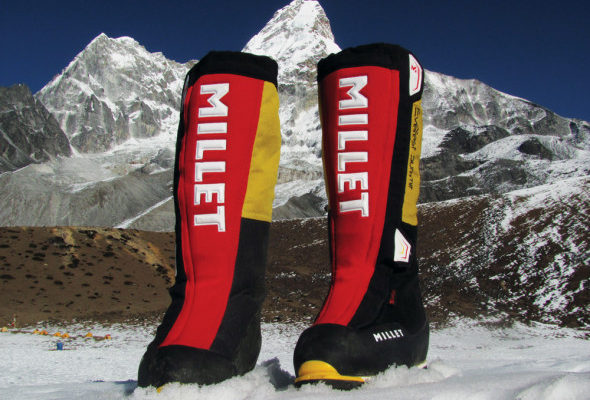Expedition leader Tim Mosedale tests out the latest version of Millet's high-altitude boots, on Ama Dablam...
I’m sure that you are well-acquainted with the concept of layering; creating air pockets and trapping layers of warm air between garments, whether that be the upper body, legs, head or hands. By removing or adding thin or thick layers you can regulate your temperature according to whether you are working hard, standing still at a belay, resting for lunch or whether the weather has changed and it is getting warmer or cooler.
With boots, however, this isn’t really an option. Apart from perhaps adding a gaiter (and even that would generally be on or off for the whole day) what you put on your feet at the start of your day is what you will probably be wearing at the end. So it is vitally important to make sure that you a) you have the right sock combination and b) that the boots are suitable for the day’s activity. In UK summer, Scottish winter or the Alps it is not uncommon for people to have three, four or even five pairs of boots that can be swapped and changed according to the weather conditions, the activity being undertaken and the length of day. On Everest (and other ultra-high altitude mountains) however, this flexible approach is not really an option. Yes there is a trekking phase where trainers, approach shoes or light hiking boots might be used, and an acclimatisation phase where plastics might be worn, but for the summit phase nothing but the warmest boots will suffice.
Exclusive club
When it comes to the arena of ultra-high altitude the choice of boots is quite limited, but that doesn’t mean that you should settle for any less than the best. The main protagonists are La Sportiva (Olympus Mons), Scarpa (8,000ers) and Millet (Everest), and The North Face is also a more recent newcomer with their Verto S8K. It’s quite difficult to compare like for like as they partly depend on the shape of the foot for the individual and it’s vitally important that you try the various models on before making your choice. One of the difficulties with high altitude boots has always been a trade-off between warmth and volume. Yes you want to have a warm boot but you don’t want a boot that is too voluminous. Conversely a slim boot will possibly be a bit light on the temperature ratings. Equally the boot has got to be up to the job in hand, be rugged and totally bombproof. And lastly it’s got to be easy to put on and take off, even in the coldest of conditions where you might be wearing thick mitts where operations are compromised by lack of dexterity.
So please step forward the most recent version of the very successful Everest Millet GTX. Personally I was never a great fan of the original Everest Millet boot as the gaiter was pretty baggy (great for getting over down-covered legs, but as they were baggier still there was a lot of potential for snagging crampons with careless footwork) and the boots were pretty floppy compared with the Scarpas and the La Sportivas. But the most recent version has a nice slim look to it and this has been accomplished by using some pretty hi-tech materials and innovations. The old-style boots had a double zipper up the front of the integral gaiter which meant that there were two things that could go wrong. Equally the Scarpa Phantom 8000 has only a single waterproof zipper which is very stiff and gives a distinct feeling of vulnerability. With either of these boots if the zipper pops there is no ‘plan B’. Even abandoning the summit attempt and retreating down the mountain will be a difficult task with a boot that has a front open and at the mercy of the elements and snow.






